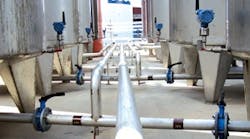In refineries, oil fields, offshore platforms, chemical plants and other industrial facilities around the world, Emerson Smart Wireless technology is helping to improve worker and plant safety, optimize operations, and reduce emissions and other environmental impacts.
At the 2012 Emerson Global Users Exchange the company marked one billion hours of operation across more than 10,000 systems, noting that more customers than ever have confidence in and have adopted wireless technologies for not only hard-to-reach, extreme applications, but also for critical, day-to-day process control and monitoring requirements.
A technology first adopted for use in harsh, remote environments where wired instrumentation was not feasible, Smart Wireless technology has proven its reliability and performance in traditionally wired applications. Just last year, a Japanese oil refinery and adjacent tank farm were badly damaged by the 9.0 magnitude earthquake and tsunami, with raging fires followed by hours of immersion in sea water. While much of the cabled instrumentation was destroyed, Emerson's wireless network was still operating after the waters receded, including a fire damaged wireless transmitter.
Since its release five years ago, Emerson estimates put the total installed savings resulting from Smart Wireless field devices at more than $350 million and reductions in commissioning and installation time at 16 man-years.
"We knew wireless technology offered substantial savings and it is gratifying to see its rapid and widespread adoption," says Bob Karschnia, Emerson Process Management vice president, wireless.
Improved plant safety is both a key driver and deliverable for many of these Smart Wireless installations. "General conditions, and the environments we work in, have become more extreme, making it more dangerous to send employees into the field to take measurements," Karschnia says. "Reliable, high-performance instrumentation, enabled by wireless, reduces safety risk every time a worker doesn't have to go into the field to check on an instrument or piece of equipment."




